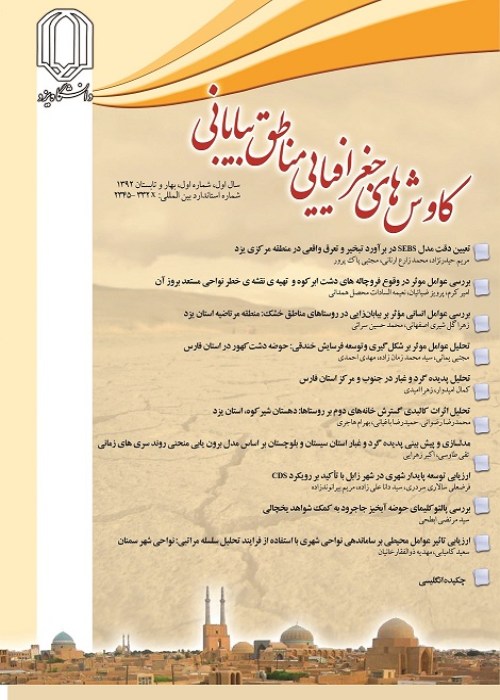Tree shadow coverage optimization on buildings in tropics by using GIS and ACO: A case study of Semnan
The UHI is the effect of the thermal properties of the constructions that results in higher temperatures in urban areas compared to the surrounding areas. The UHI intensifies heat waves during the summer and increases energy consumption. Well-known UHI reduction methods utilize increased vegetation such as shading surfaces through increased tree coverage on buildings. In this research, we focus on the strategic planning of shade trees, which has been shown to provide energy and long-term cost savings to enhance the environmental quality of the urban ecosystem. A simple method to create abundant shade involves planting as many trees as possible on all sides of the building. This approach, however, isn’t practical because of the cost of trees as well as water restrictions in many water-regulated communities. Similarly, excessive shading reduces the possibility of holding exposed rooftops for placing electricity-generating solar panels. The goal of this research is to consider where to optimally and precisely locate shade trees around the building such that a) the shading of the facade, windows, and doors of the building is maximized but the rooftop shade is minimized, and b) spatial optimization is creatively used to find the best tree locations quantitatively in a 3-dimensional (3D) environment. In this study, therefore, a 3D spatial optimization model is presented to identify optimal tree locations for residential structures by integrating the GIS with ACO methods to solve this problem as a mathematical model. The modeling is done on a residential building in Semnan City, where tree shade coverage, water conservation, and solar energy potential are critical because of the hot and dry conditions.
A 3D representation of a building is used with the height and dimensions of 3 m and 12×12 m2 respectively. The building has three windows with a dimension of 1.6 × 2 m2 on the north, east and, west facades and two windows and one door with a dimension of 2 × 3.2 m2 on the south facade. To represent a 3D tree, a simple design of pine with a height of 6 m and a crown radius of 2 m is used. Then, the theory of Duffie and Beckman (2013) is used in GIS to store the positions of 3D objects and extract shade coverage. Also, the MCLP is defined according to Church and Murray (2009). The details of the optimization steps are as follows: a) Defining a set of possible tree positions based on the height, crown radius, surrounding area, and outlook of the building b) Using a method for locating the first tree in all the possible positions around the building in the hot hours of certain summer days, then calculating the maximum shading on the building based on the weight of building components c) Eliminating the possible positions within the tree crown to prevent their overlap d) Repeating steps 2 and 3 to locate the next trees in possible positions around the building block until the trees reach the required number for shading There are three reasons for using ACO for 3D position optimization as follows: 1) The complexity of computing the shading on the building, especially using a highly-detailed 3D model for the tree and building 2) The lack of a particular method to solve the optimization problem considering the nonlinear constraints, including trigonometric functions 3) The constant space around the building block, making it possible to locate trees anywhere Therefore, there are infinite combinations of multiple trees in the solution space. Considering the infinite possible positions, a simplification step is required to limit the number of the available positions. So, the constant space is reduced to possible positions for locating Ni trees with two-meter spacing in the N-S and E-W directions. Further, the possible tree positions in front of the opening components are eliminated to make daylight available, have an outlook from the building, and commute through the doors. The minimum spacing of two meters between the trees and the building is set to prevent unnecessary shading on the rooftop.
A computer program is developed to maximize the shade coverage on the facade/opening and minimize it on the rooftop via ACO in Matlab. The results show that, for a building in the northern hemisphere, the trees in the north of the building have no effect in shade coverage on the building. Finding the best location for trees depends a lot on the position of the opening in the building, because of the high heat transfer through the opening versus the facade and rooftop. Table 1 shows the percentage of shade coverage on building components from 9 to 15 o’clock in four sample summer days when one to three trees are planted in suitable places around the building. Table 1. Percentage of the shadow created by tress on the building components Number of trees The best location Percentage of shadow on facade Percentage of shadow on opening Percentage of shadow on rooftop 1 Location K8 on the south 14.73% 23.08% 3% 2 Location K8 on the south & H11 on the east 26.21% 30.77% 5% 3 Location K8 on the south, H11 on the east & H3 on the west 36.04% 38.46% 7%
In this study, in addition to the determination of the shade coverage of trees, a model is used for 3D spatial optimization to predict the optimal positions of trees for shade coverage on a 3D building. For this purpose, 3D modeling and GIS location processing have been done to determine the 3D geometric characteristics of the building, aiming to optimize the tree shadow on the building. The ACO algorithm is used to create the mathematical model to determine the optimal tree position and achieve optimal tree shading on the building. This study is one of the first attempts at determining the exact position and number of trees needed for optimal tree shading on a residential building in Iran.
- حق عضویت دریافتی صرف حمایت از نشریات عضو و نگهداری، تکمیل و توسعه مگیران میشود.
- پرداخت حق اشتراک و دانلود مقالات اجازه بازنشر آن در سایر رسانههای چاپی و دیجیتال را به کاربر نمیدهد.



